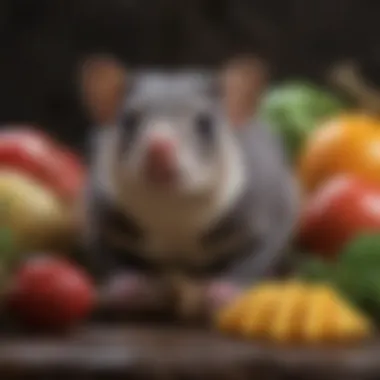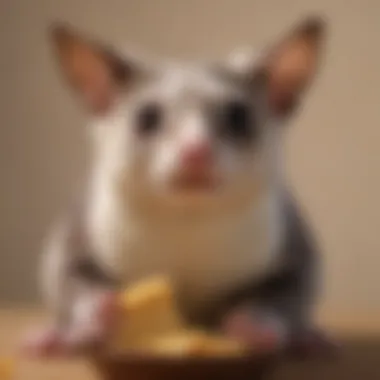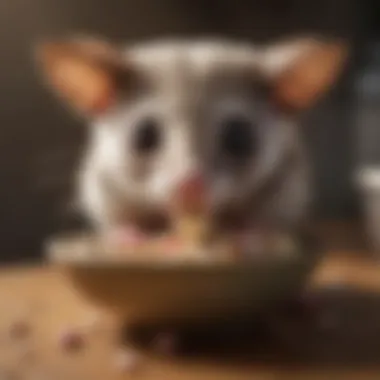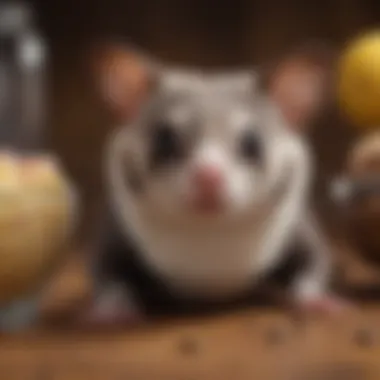Understanding Sugar Glider Nutrition: A Complete Guide


Intro
Sugar gliders are nocturnal marsupials that require specific care, notably when it comes to their diet. Understanding their nutritional needs can significantly enhance their quality of life. If you are a sugar glider owner or considering becoming one, grasping issues like feeding practices, food options, and dietary balance is pivotal. This detailed exploration aims to illuminate the core aspects that affect their dietary habits and overall well-being.
Care Tips
Taking care of a sugar glider involves daily routines and setup parameters tailored to their unique needs.
Daily Care Routines
Consistency is essential in keeping sugar gliders healthy. They thrive on a schedule. Engage with them daily; this builds trust and reduces stress. Feeding time can be a bonding experience as well, so utilize it wisely.
Cage Setup and Maintenance
The cage environment plays a crucial role in a sugar glider's happiness. The cage should be spacious, allowing them room to glide and play. A multi-level setup can promote exercise and exploration. Ensure proper ventilation and secure areas without sharp edges or harmful extensions.
Hygiene and Cleaning Practices
Regular cleaning keeps both the environment and the sugar glider healthy. The cage needs thorough cleaning weekly, including replacing bedding and sanitizing food dishes. Keeping their living space clean minimizes parasites and diseases.
Seasonal Care Adjustments
Be mindful of temperature changes. Sugar gliders are sensitive to extreme heat and cold. Adjust their habitat to suit seasonal demands. Offer additional warm covers in colder months or shaded areas in summer to maintain a comfortable habitat.
Nutrition Guides
Understanding proper nutrition contributes greatly to long-term health.
Essential Diet Components
A well-balanced diet includes a mix of fruits, vegetables, and protein. Consider options such as:
- Grapes
- Carrots
- Cooked superhero food like chicken or egg These offer needed nutrients regularly.
Safe and Toxic Foods
Preventing food-related illnesses is crucial. Some toxic foods include chocolate, caffeine, and avocado. Refer to reputable guides to ascertain what's safe and which substances to omit completely.
Supplements and Treats
Sometimes, supplements such as calcium and vitamin A may be needed. Discuss dosage with a vet to ensure proper integration into diet. Treats should be given in moderation.
Feeding Strategies for Different Species
Consider their unique dietary needs: certain species may thrive better on specific diets or based on lifestyle.
Wellness and Health
Maintaining wellness in your sugar glider can often depend on how observant an owner you are.
Routine Health Checkups
Regular vet visits are vital to preempt ailments. Keep records of any health abnormalities for vet reference.
Identifying Symptoms of Illness
Learn common symptoms like fatigue or decreased appetite. Early detection is necessary; don’t wait too long to seek help.
Preventative Care and Vaccinations
Vaccination against common diseases strengthens defenses. An experienced veterinarian can sketch out an appropriate vaccination plan.
Mental and Emotional Well-being
Sugar gliders desire social interaction. Loneliness can contribute to distress. Active engagement is the key to a content animal.
Enriching Activities
Life in captivity should include stimulation, both mental and physical.
Toys and Playtime Ideas
Introduce different toys—math beads, for example—for enhancing handling. Avoid toys that could be choking hazards.
Training and Tricks


Training your sugar glider to perform tricks can perform a dual role. It builds trust while providing significant mental exercise.
Outdoor Activities and Interaction
Photograph outings can enrich their senses. Safety must be your top priority here. Always supervise when outside.
DIY Projects for Mental Stimulation
Creating simple, engaging structures stimulates imagination and awareness. Simple bridges made from natural materials can be safe ways to enhance interaction.
A sugar glider's well-being is partly tied to an engaged environment. By focusing on social and emotional elements, you are investing in their happiness.
Understanding these aspects of caregiving contributes to making informed decisions that can help you be an effective sugar glider owner. By implementing a thoughtful balance of diet, care, and mental stimulation, you can enhance the quality of life for your sugar glider, promoting longevity and wellness.
Intro to Sugar Gliders
Sugar gliders are small, nocturnal marsupials native to Australia, Tasmania, and New Guinea. Understanding these unique animals is crucial for anyone considering them as a pet. This section aims to introduce sugar gliders, highlighting their natural behaviors and social needs, which in turn explains their specific dietary requirements.
Understanding Sugar Gliders
Sugar gliders, traditionally not domestic animals, thrive in a social structure. They exhibit strong bonding behaviors, primarily in pairs or small colonies. Recognizing this aspect is essential for pet owners. A single sugar glider may suffer from loneliness, leading to stress or health problems. Educating oneself about their habitats and natural diet informs pet owners on how to meet their nutrition needs.
This species primarily feeds on a diet consisting of nectar, fruits, and insects in the wild. Therefore, when establishing a diet for pet sugar gliders, one must consider mimicry of their natural intake. Proper understanding strengthens the bond between extreme care and attention to dietary needs.
A key element in ensuring healthy sugar glider care is knowledge referral regarding existing guidelines. Online forums, social media communities dedicated to sugar glider enthusiasts, and reputable articles can provide essential updates on diet and health. Awareness of their social, behavioral and nutritional characteristics lays the crucial foundation for their well-being in captivity.
The Importance of Nutrition
Nutrition is fundamental for maintaining optimal health in sugar gliders. Their physiology is adapted for a specific diet; thus, any discrepancy can lead to health-related issues. An understanding of nutritional balance aids greatly in providing a longer life and sustaining joyful temperament.
Proper nutrition is not just about feeding. It’s about providing a spectrum of nutrients that work cohesively in their body.
Sugar gliders require a diet rich in essential macronutrients and micronutrients. Proteins, fats, and carbohydrates, along with various vitamins and minerals, must be integrated daily. Knowledge about these needs enables owners to select appropriate diets, avoiding formulations with excessive sugars or fillers common in many commercial pet foods.
A significant risk includes poor nutrition leading to weaknesses in the immune system or even obesity. Regular assessment of their dietary intake, thorough understanding of allowed and forbidden foods, are all part of responsible ownership. Moreover, balancing portion sizes can prevent overfeeding, which is just as critical as feeding the right types of food. This adds more responsibility on the owner, compelling them to study and acknowledge all aspects of dietary requirements.
In essence, the profound understanding of sugar gliders extends far beyond simply providing food. Grasping their nutritional needs enriches their lives, promotes health, and enhances the bonds they share with their caregivers.
Nutritional Requirements
The health of sugar gliders hinges significantly on their proper nutrition. Understanding nutritional requirements ensures that these small marsupials thrive and maintain their playful, vibrant nature. Each nutrient plays a unique role in their overall health. Proper attention to these requirements helps prevent common health issues, such as obesity or nutritional deficiencies, which are otherwise common. This article will delve into macronutrients and micronutrients, exploring each in detail. Using this information, pet owners can provide balanced, nutritious diets for their sugar gliders.
Macronutrients
Macronutrients are the primary building blocks of a sugar glider’s diet. They consist of proteins, fats, and carbohydrates. Each type of macronutrient serves essential roles in growth, energy, and overall well-being.
Proteins
Proteins are vital for sugar gliders’ growth and development. They contribute to tissue repair and enzymatic functions. The key characteristic of proteins is their amino acid composition, with certain amino acids being essential for health and cannot be synthesized by the gliders themselves.
Benefits of protein:
- Supports muscle growth
- Aids in maintaining energy levels
- Helps in repairing body tissues
Unique feature of proteins: They can be sourced from both animal and plant-based foods. Animal proteins, such as insects, provide a complete amino acid profile. Placing more emphasis on animal protein largely benefits overall health. However, there is a risk of overfeeding protein sources, leading to potential health complications.
Fats
Fats serve as an essential energy source for sugar gliders without the drastic insulin spikes seen with sugary foods. The main characteristic of fats is their energy density, making them a concentrated source of calories. They also play roles in hormone production and absorption of fat-soluble vitamins.
Benefits of fats:
- Provide energy for daily activities
- Help maintain healthy skin and fur
- Support brain development and function
Unique features of fats: There are different types of fats, including saturated and unsaturated fats. It is important to prioritize healthy sources, such as oils from nuts or seeds, while limiting saturated fats. Sufficient fat levels will ensure that sugar gliders remain active, but too much can lead to obesity.
Carbohydrates
Carbohydrates constitute another integral part of sugar glider diets. While essential for energy, not all carbs are equally beneficial. The unique aspect of carbohydrates is their varying complexity and fiber content, crucial for digestion.
Benefits of carbohydrates:
- Provide a quick energy source
- Facilitate digestive health through fiber
Unique feature of carbohydrates: Notably, some options are more nutritious than others. Fruits and vegetables offer a balance of natural sugars and fiber. However, excessive intake of high-sugar fruits can encourage weight gain, so moderation is key.


Micronutrients
While macronutrients are important, sugar gliders also require micronutrients to support their health. Micronutrients encompass vitamins and minerals, which assist in various physiological processes, enhancing metabolic function and fortifying bones and teeth.
Vitamins
Vitamins are organic compounds necessary for various metabolic functions. Each vitamin has specific roles, such as supporting vision, promoting skin health, or aiding in the utilization of calcium. The primary characteristic of vitamins is that they must be supplied through dietary choices since sugar gliders are unable to synthesize them.
Vitamins benefits include:
- Support for immune function
- Promotion of healthy growth
- Maintenance of cellular processes
Unique features of vitamins: Water-soluble vitamins must be supplied regularly, as they can be lost through urine. Fat-soluble vitamins, obtained from fatty foods, can accumulate and may pose toxicity risks if overconsumed.
Minerals
Minerals are essential inorganic elements that play a role in structural and regulatory functions in sugar glider bodies. Calcium, phosphorus, and potassium are fundamental since they are involved in bone health, muscle function, and hydration balance.
Benefits of minerals include:
- Maintaining strong bones and teeth
- Aiding enzyme action
- Supporting nerve function
Unique feature of minerals: Some minerals can be sourced from commercial diets while others must come from natural foods. A balanced intake of minerals is crucial; imbalances can cause health issues such as metabolic bone disease.
Properly understanding nutritional requirements promotes longevity and enhances the quality of life for sugar gliders.
Commercial Pet Foods
Commercial pet foods play an essential role in maintaining the health and well-being of sugar gliders. These products are designed to meet the nutritional requirements of these small marsupials, providing a convenient solution for pet owners. Proper nutrition ensures that sugar gliders receive balanced diets that support their growth, energy levels, and overall vitality. Understanding the types and qualities of commercial diets helps caregivers make informed decisions, guaranteeing their pets live healthy lives.
Types of Commercial Diets
Dried Pellets
Dried pellets are a common choice for feeding sugar gliders. They often offer a balanced combination of nutrients, developed specifically for the species. A vital characteristic of dried pellets is their long shelf life, making them easy to store and feed. Their convenience plays a significant role in their popularity among sugar glider owners.
Canned Foods
Canned foods present a different feeding option for sugar gliders. A key advantage of canned foods is their high moisture content, which helps with hydration. Many canned products also combine a range of ingredients including fruits and proteins, increasing the diversity in texture and flavor. This can be particularly appealing to sugar gliders who are sometimes picky eaters.
Nevertheless, parents should be mindful of sugar content and preservatives in certain canned products. Reading labels becomes essential to avoid excessive sugars or harmful additives that could affect health. Canned foods can complement diets, provided they are chosen wisely.
Treats
Treats can be used as a positive reinforcement in the feeding routine for sugar gliders. This variety plays a very important role in maintaining engagement and interest in their diet. By providing rewards, like dried fruits or special insects, caregivers can reinforce good behavior but should keep moderation in mind.
The unique feature of treats is their appeal, stimulating the natural curiosity and playfulness that sugar gliders exhibit. Available options often include healthy, protein-rich snacks that can aid in obtaining vital nutrients. However, excessive treat consumption may lead to imbalances in dieting, contributing to problems like obesity. Care needs careful monitoring to ensure treats serve their purpose without becoming a detrimental factor in the overall diet.
Evaluating Commercial Brands
When selecting commercial pet foods, evaluating brands becomes paramount to ensuring quality nutrition for sugar gliders. Consider conducting thorough research about ingredient sourcing, nutritional values, and customer feedback regarding different products.
Identifying trusted brands rooted in reputable practices leads to more informed buying decisions, benefitting the health of the pet. Avoid falling into the traps of flashy advertisements or provably unsubstantiated health claims prominently sought by a majority of new earners.
In essence, a well-rounded understanding and conscientious evaluation of commercial pet foods can significantly contribute to the health and well-being of sugar gliders, equipping caregivers to enhance their overall care.
Natural Foods for Sugar Gliders
Natural foods play a pivotal role in the diets of sugar gliders. These small marsupials require a variety of nutrients to sustain their energetic lifestyles. Providing a natural diet can result in numerous health benefits while enhancing their overall well-being. It mimics their wild diet, ensuring they receive essential macros and micronutrients. Such foods can also foment behavioral enrichment, as foraging for food replicates their wild instincts. This section will delve into specific categories of natural foods that nurture and support sugar gliders in captivity.
Feeding Practices
Feeding practices are critical for ensuring the health and well-being of sugar gliders. Proper feeding not only prevents nutritional deficiencies but also maintains a balance between energetic needs and health. Two primary factors in effective feeding practices are frequency of feeding and portion control, both of which are vital in keeping your sugar glider in optimal health.
Frequency of Feeding
The frequency of feeding sugar gliders addresses the need for their dietary habits and natural instincts. Sugar gliders are nocturnal creatures, which means they are most active at night. This aspect influences when and how often they should be fed.
Generally, sugar gliders thrive on a feeding schedule that offers food twice a day, preferably once in the morning and once in the evening. During these meal times, it is essential to provide a mix of commercial feed and natural foods conducive to their health.
Considerations for frequency include:
- Sugar gliders are social animals and can benefit from interacting with their owners during feeding time.
- Establishing a consistent routine helps them adjust and reduces stress.
- Regular feeding times assist in monitoring any changes in appetite or health issues.
Portion Control


Controlling portion sizes is equally important in maintaining a sugar glider's weight and overall health. Overfeeding can lead to obesity, which presents long-term health risks such as diabetes or heart diseases. Recognizing how much food to provide is critical.
When evaluating portion control, bear in mind the following:
- A moderate serving of a mix of fruits, vegetables, and protein sources should equal around 10-15% of the sugar glider's body weight.
- Monitor their activity levels; highly active sugar gliders may require slightly larger portions.
- Avoid high-calorie treats, as they can lead to poor dietary practices if given too frequently.
Regularly analyzing your sugar glider’s behavior, health, and body condition helps ensure an appropriate portion size. This careful monitoring encourages a healthy and happy pet.
Setting up adequate feeding practices requires thoughtfulness. Owners should blend professional guidance with personal observation to optimize the diet of sugar gliders and ensure their long-term health.
Common Nutritional Issues
Understanding common nutritional issues in sugar gliders is essential for maintaining their health and well-being. These small marsupials have unique dietary requirements that, if unmet, can lead to severe health problems. Awareness of nutritional issues allows pet owners to take proactive measures for their sugar gliders. Each sugar glider varies; thus, individualized attention to their diet must be considered.
Obesity
Obesity is a prevalent issue in sugar gliders, arising from overfeeding or offering inappropriate foods. Many pet owners may not recognize the signs of obesity until it has reached damaging levels. Weight management is crucial, as obesity can lead to metabolic disorders, reduced mobility, and decreased lifespan.
- Causes of Obesity:
- Identifying Obesity:
- Overfeeding: Many sugar gliders can overeat when leftovers or high-fat treats are frequently available.
- Lack of Exercise: Insufficient activity levels contribute to weight gain. Sugar gliders require daily opportunities for play and movement.
- High-Fat Diet: Apart from treats, diets too rich in fats can accelerate weight gain.
- Weight Monitoring: Regular tracking of weight can help identify changes.
- Physical Appearance: Pay attention to the round shape of the torso or the inability to see the glider’s waist, indicating weight problems.
Managing obesity involves careful control of their diet and engagement without being aggressive. Introducing exercise through interactive activities or climbing equipment in their cages can supplement a balanced diet effectively. Decreasing the quantity of high-calorie foods while replacing them with healthier options can stabilize weight.
Nutritional Deficiencies
Nutritional deficiencies represent another significant challenge in maintaining the health of sugar gliders. Various factors can lead to these deficiencies. Thus, balance is vital in their nutrition.
- Types of Deficiencies:
- Causes of Deficiencies:
- Calcium Deficiency: Critical for bone health; low calcium can cause severe health issues like metabolic bone disease overnight.
- Vitamin Imbalances: Sugar gliders also require sufficient Vitamin A, Vitamin D, and B vitamins. These deficiencies lead to skin disorders, weakened immune systems, or lethargy.
- Poor Diet Choices: Relying only on commercial diets or limited food types restricts nutrition.
- Inadequate Supplementation: Not including necessary vitamins or minerals supplements can worsen deficiencies.
To prevent nutritional deficiencies, it's recommend to provide a diverse diet. Incorporating a wide array of fruits, vegetables, and specially calamities formulated for sugar gliders-balanced proportions are paramount. Consulting a veterinarian, assists with assessing and adjusting dietary needs tailored to specific health status, assuring all necessary nutrients are consumed.
Understanding nutritional issues ensures pet owners make better food choices and supports their sugar gliders’ long audventrous lives.
Monitoring Health Through Diet
Monitoring the health of a sugar glider through diet is paramount. The foods these creatures consume have direct impacts on their overall well-being. Balanced nutrition plays a critical role in their physical health and longevity. A thorough understanding of dietary influences enables pet owners to make informed decisions, enhancing the quality of life for these unique pets.
Poor nutrition can lead to various health issues, some of which may not be immediately noticeable. Regular monitoring allows early detection of potential problems. Observing changes in behavior, energy levels, and physical condition provides valuable insights into a sugar glider's dietary adequacy.
Signs of Poor Nutrition
Recognizing the signs of poor nutrition in sugar gliders is essential for timely intervention. Some common symptoms include:
- Weight Changes: Significant weight gain or loss can indicate dietary imbalances.
- Lethargy: Reduced energy levels may suggest inadequate caloric intake or poor nutrient absorption.
- Dental Issues: Malnutrition can lead to dental problems, which are often visible in a sugar glider's grooming habits.
- Skin and Coat Quality: Dull, flaky skin or a lack-luster coat may signal nutrient deficiencies.
- Changes in Behavior: Increased irritability, stress, or aggression can sometimes stem from poor dietary quality.
Ensuring proper diet prevents these signs from developing. Ingredients with the right balance of nutrients are fundamental to a sugar glider’s robust health.
Consulting a Veterinarian
Regular consultations with a veterinarian are a critical part of monitoring a sugar glider’s diet. Vets can provide tailored advice based on each individual pet’s needs. They can identify nutritional deficiencies that may not yet show visible signs. Specific tests can reveal imbalances that need correction, aiding in informed dietary adjustments.
Conversing with a vet about any observed issues can lead to developing an optimal diet plan. This mutual exchange of information ensures that to maintain a healthy lifestyle for sugar gliders. Also, consulting with experts ensures that treatments align with best practices specific to the species.
To sum up, both monitoring dietary health and consulting veterinary professionals are crucial steps towards ensuring well-being in sugar gliders. Actively addressing nutrition means preventing complications and enhancing the overall health experience for these small exotic pets.
Epilogue
The conclusion serves as a critical summary that encapsulates the main ideas presented in this article about sugar glider nutrition and pet food options. Proper nutrition is not merely about providing food; it forms the foundation of health and well-being for sugar gliders, imperative for their longevity and vitality. This section highlights the importance of customized diets and how they directly affect a sugar glider's overall health. As pet owners, understanding these dietary principles benefits both the pet and owner, leading to healthier and happier relationships.
Summary of Key Points
In view of our earlier discussions, several key points crystallize:
- The nutritional requirements of sugar gliders must align with their unique physiology. Adequate levels of proteins, fats, and carbohydrates are essential to maintain their health.
- Different food options like commercial pet food and natural foods must be carefully evaluated to avoid nutritional deficiencies.
- Regular observation of dietary habits and any signs of health issues ensures timely interventions.
- It's crucial to establish feeding practices that consider the frequency and portion sizes, which directly influence a pet's diet quality.
“An informed pet owner is one step closer to a healthier pet.”
Future Considerations in Sugar Glider Nutrition
As we peer into the future of sugar glider nutrition, several considerations emerge that warrant attention:
- Advances in research could redefine nutritional guidelines for sugar gliders. Staying informed about new studies will enable owners to provide optimal diets.
- The advent of more natural and holistic food alternatives may provide new solutions that align closely with a sugar glider's needs, particularly those living in homes rather than in the wild.
- Veterinary consultations should continuously adapt and encourage dynamic approaches to nutrition that reflect changes in individual health status or growth stages of these pets.
Maintaining an open dialogue with veterinarians can promote adjustments in feeding practices as more knowledge becomes available, enhancing the sugar glider's life experience significantly.















